If you have ever lived in Japan, the Kotatsu table must be one of the things that you miss the most when you are living abroad. There is nothing quite like the precious family time and memories created around a Kotatsu table as everyone gathers around it on cold winter days to warm their body, heart, and soul.
A Kotatsu table is a low-lying wooden table with a heat source inside covered by a futon or heavy blanket with a tabletop. The Kotatsu originated in the 14th century as a hearth in a center of a home. Now the Kotatsu is portable and a staple in every Japanese household.
Although it is an essential item for any Japanese household, it is certainly very rare in other parts of the world, and hence it is one of those things about Japan that is shrouded in mystery to many. But today, we are going to bring to light everything you need to know about it, which will answer any question you might have about the Kotatsu table. Let’s begin!
What is a Kotatsu Table?
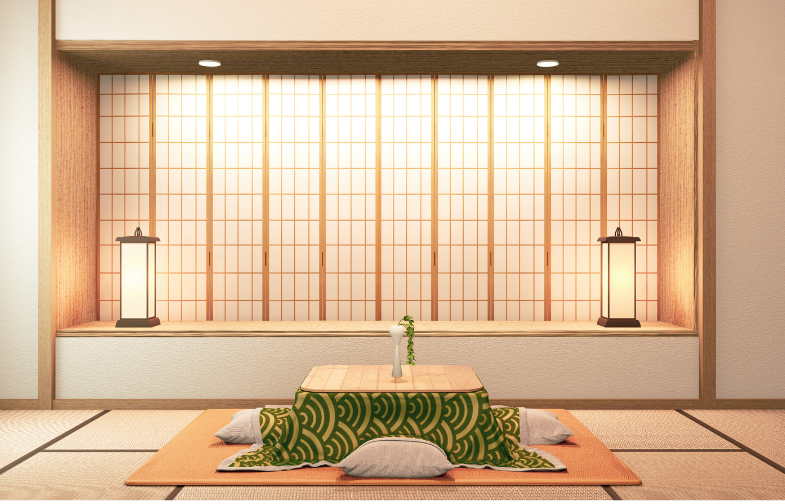
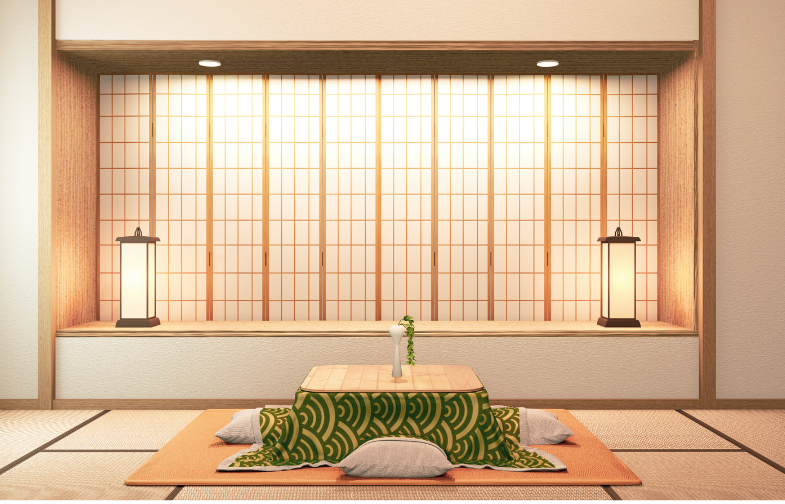
Shop Kotatsu on ZenMarket
The heat emitted from the heat source inside a kotatsu is trapped by a blanket that covers the sides of the table. The heat source used to be charcoal in the past, but in modern times, it is usually an electric heater attached to the inner surface of the tabletop, which is safer and allows more legroom under the table.
The Kotatsu is usually placed on the floor, and you sit with your legs crossed or stretched out under the table with the blanket covering the lower half of your body, keeping you warm and cozy. While sitting at the Kotatsu table, you can use the tabletop for working, eating, reading, etc. Kotatsu table is also great for taking naps as you can lie down with the lower half of your body warmed by the heat inside, and depending on the size of the blanket, you can keep half or all of your body covered.
Although a Kotatsu table might appear like a humble piece of furniture, it is a lot more than just a household object. During the winter in a Japanese household, the Kotatsu table is the center of family life. The closest thing to a Kotatsu in the West would be a fireplace. A place where the family gathers around to have dinner, watch TV, have a lovely tea-time, take a cozy nap together, etc.
Grandparents telling stories to the children, a father reading a newspaper, a mother getting some knitting done, a family sharing a hot pot meal, friends playing a board game, a student pulling out an all-nighter are everyday scenes that happen around a Kotatsu table in Japan. As you can see, a Kotatsu table is not only a piece of furniture; it is a symbol of nostalgia, comfort, and family life and an essential part of Japanese culture and traditions.
Common Features of a Kotatsu Table
Low-height table: The tell-tale features of a kotatsu table are its low height of around 35 to 50 cm, rectangular shape, and is made of wood. Contemporary kotatsu table makers offer many variations in size, design, and functionality, and we will get to more on it in the following sections.
Blanket: Kotatsu-buton (掛布団) is the futon or blanket, usually thick and quilted, draped over the futon to cover the sides of the kotatsu table. This prevents the heat from escaping and provides comfort and cushioning around your waist when sitting at the kotatsu table.
Heating element: The quintessential component of a Kotatsu table, the heating element is usually an electric heater attached to the bottom surface of a Kotatsu tabletop.
Kotatsu’s heaters are equipped with safety mechanisms and the ability to heat the surroundings very quickly.
Additional Components of a Kotatsu Table:
Kotatsu Mat: Traditional Japanese houses have tatami (soft rush and straw weave) flooring, which is not as hard as wooden or concrete flooring. However, modern homes and their harder floor surfaces require some kind of cushioning to act as a seating area for the Kotatsu table. Today, Kotatsu mat or Kotatsu rugs are commonly used with a Kotatsu table. They are placed under the Kotatsu table in a way so that it covers the seating area surrounding the table.
Zabuton (座布団): Zaubuton is a traditional Japanese-style cushion used for sitting on the floor. Not only is it super comfy, but it can also add Japanese aesthetics to go with the Kotatsu table. Zabuton is a significant part of Japanese culture and traditions – it is used in Zen meditations, Japanese theater, Sumo wrestling, etc.
Zaisu (座椅子): Zaisu is a Japanese-style chair with back support similar to standard chairs but without legs. Zaisu might have one, two, or no armrests, depending on the design. Zabuton can be used on top of a Zaisu to provide cushioning. A Zaisu is an excellent addition to a Kotatsu table as it allows you to sit and work at a Kotatsu table for a long time without hurting your back and neck.
Two main types of Kotatsu
These days, there are many types of Kotatsu depending on the design, size, heater type, etc. However, all Kotatsu can be broadly classified into two main categories.
Hori-gotatsu (掘り炬燵): The term ‘Hori’ comes from the Japanese word for ‘digging.’ As the name implies, this type of Kotatsu consists of a table placed on top of a pit about 40cm deep that has been dug into the floor. The type of heating element used in a Hori-gotatsu is usually a charcoal heater placed somewhere inside the pit. This allows you to sit with your legs lowered into the pit. Hori-gotatsu is the more traditional form of a kotatsu, and today, it is extremely rare, only present in very old Japanese-style homes.
Oki-gotatsu (置き炬燵): “Oki” comes from the Japanese word ‘to place’ and it is so-called because the Kotatsu table is placed right on top of the floor surface. The type of heating element used in Oki-gotatsu is an electric heater usually attached to the lower surface of the kotatsu table. Almost all modern kotatsu tables are Oki-gotatsu as they are much safer and are more compatible with modern home architecture. Therefore, we will only be focusing on this type of Kotatsu going forward in this article.
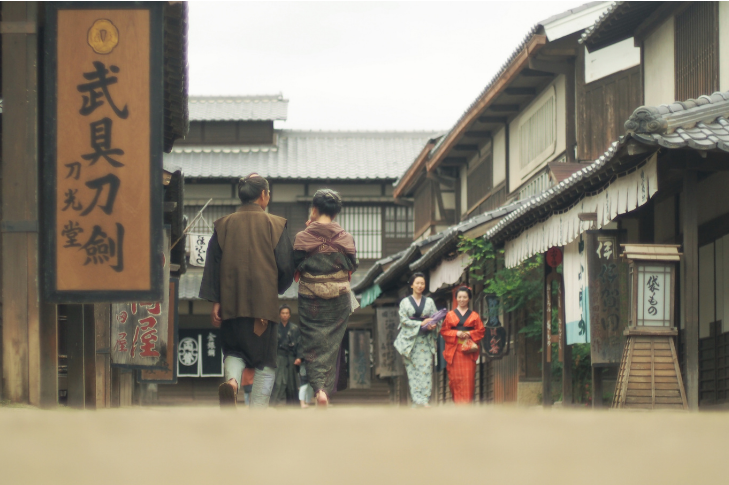
Where Did the Kotatsu Come From?
Although the rest of the world has yet to catch up with the wonders of the kotatsu table, you will be surprised to know that kotatsu tables and their predecessors have been around in Japan for more than 700 years! Let’s take a look at the fascinating background story of the kotatsu table.
Muromachi period (1336 to 1573): The origin of the kotatsu table can be traced back to something called Irori. Irori is a sunken hearth consisting of a square-shaped pit dug into the floor with charcoal placed inside it and a pothook suspended over it. The charcoal burning in the Irori at the center of the household was where all the cooking and heating happened.
By the middle of the Muromachi era, the Irori was modified in a way so that people could sit around it by placing a wooden platform and a quilt over it, thus turning it from a simple cooking area to a place where the family gathered around to spend time while they warmed themselves. This was the most primitive form of a Hori-gotatsu.
Edo period (17th century): During the Edo period, hibachi, a Japanese-style brazier, replaced the Irori pit as the heat source for Kotatsu. It allowed the Kotatsu to be moved around instead of being a permanent floor fixture. This was the beginning of the Oki-gotatsu.
Early 20th century to modern times: In 1909, a British pottery maker Bernard Leach created a version of Kotatsu with a sunken floor in his Tokyo house while living in Japan. His version of Kotatsu popularized the use of Kotatsu in modern Japanese households.
Although electric kotatsu tables were available since the Taisho era (1912 – 1926), they were not used in common households until Toshiba released their Nichrome Infrared Electric Kotatsu in 1957. This was a nationwide hit, and since then, the portable electrical Oki-gotatsu has become the mainstream kotatsu table in Japan.
Advantages of a Kotatsu Table
Modern technology offers so many different options to keep you warm during the winter and you might wonder, why Kotatsu? Here are the reasons why.
Highly Energy-Efficient: The power consumption of a Kotatsu is usually around 500W-600W, and it can even be as low as 70W. Compared to similar appliances such as AC heater (approx. 750W), fan heater (approx. 2400 W), and wall unit heater (approx. 1500W), the kotatsu table is highly energy efficient. This is not only good news for the environment, but it means your electricity bills will be much cheaper. In Japan, the electricity bill for running a Kotatsu heater is about 5 JPY (about 0.045 USD) per hour.
These days, Kotatsu tables that are made to be even more energy-efficient are available such as the ones equipped with motion sensors so that it will automatically turn itself off when nobody is around.
Easy to use and convenient: All you need to do to operate a Kotatsu table is to turn on a switch. It doesn’t get any easier! Also, it does not require extra work like adding fuel, which is the case for other home heating appliances like oil stoves.
During the seasons when the Kotatsu table is not in use, the blanket can be removed, and the table can be used just like a regular table. Some modern Kotatsu tables are foldable, making them even more convenient in portability and storage.
Better for indoor air quality: When you run oil heaters such as kerosene stoves, the unpleasant odor of fuel is inevitable. On top of that, the burning of fuel releases polluting chemicals such as carbon monoxide and nitrogen dioxide, which are bad for the environment and bad for human health. Since Kotatsu tables use electric heaters, these unwanted effects on the indoor air are effectively avoided. On the other hand, air conditioning to heat the room can cause the air to become too dry, which can also be avoided using a Kotatsu table instead.
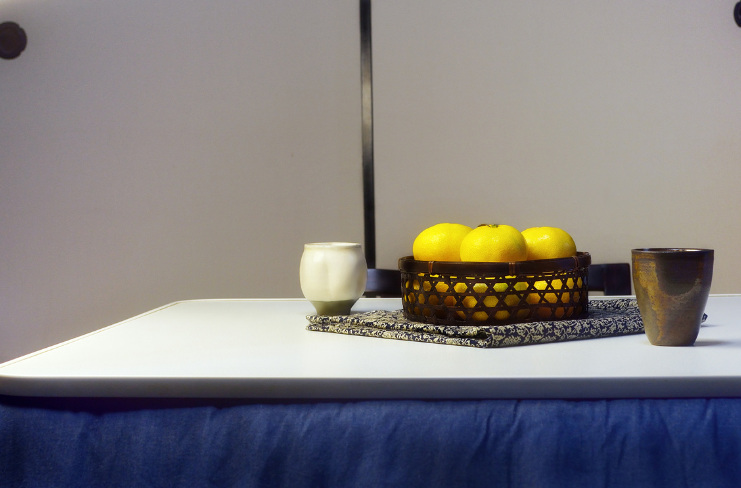
Where to Buy Kotatsu Tables in Japan?
In Japan, Kotatsu tables and related accessories can be found in the following places:
Electronic appliances megastores: They have stores all across Japan, and they have a good selection of Kotatsu tables.Examples: Yodobashi Camera, Yamada Denki, Bic Camera.
Home Centers: They are large stores with a wide range of products, including home furnishings, DIY tools and equipment, as well as kitchen and home appliances, etc. Some of the big brands in this category have spacious outlets in numerous locations across Japan. These shops offer more versatility in terms of design, including innovative ones such as foldable Kotatsu tables, and Dining Kotatsu set, etc. Examples: NAFCO, Nitori.
Online shopping sites: Kotatsu tables can be bought from the official websites of the shops mentioned above as well as from popular Japanese shopping sites such as Amazon Japan, Rakuten, and JDirectItems Shopping.
One thing to keep in mind about purchasing Kotatsu tables online is the shipping as Kotatsu tables consist of multiple components, which are all bulky items to be shipped.
Shop Kotatsu on ZenMarket
How to Choose a Kotatsu Table
Factors to consider when buying a Kotatsu for your home
A Kotatsu table is one of those things that you didn’t know you needed until you came to know they existed. You might be feeling like you are ready to welcome the winter with open arms and your very own Kotatsu table. However, before you buy your Kotatsu table, make sure to read through this section, where we share all the insider tips on choosing a Kotatsu table that is perfect for you and your home.
Separate components or a complete Kotatsu set
The first thing to think about before your kotatsu shopping is buying a complete kotatsu package including all the necessary parts such as the table, heater, blanket, etc., or buying the parts separately. When you buy the complete kotatsu set, you do not have to worry about installing the heater onto the table, matching the blanket and table size, etc. However, if you do not mind some minimal DIY work, by all means, go for the separate parts. It will give you more options, better designs, and is a lot more fun!
Size (length and seating capacity) and Shape of the Kotatsu Table
Square: Compact and a space-saver, the square-shaped Kotatsu tables can be used by single people living on their own, as well as by a small family living in a small apartment.
For a standard-sized square-shaped kotatsu table, each side is about 75cm. The 75cm size is not too wide nor too narrow and is perfect as a living room table for a one-person household. If it is for a particularly small place, such as a studio apartment, square-shaped kotatsu tables with 60 cm sides are also available.
Rectangular: Rectangular Kotatsu tables are the most common shape and offer the most versatility in size and design. The standard-size rectangular kotatsu tables are perfect for family settings and can seat two to four family members, even accommodating guests on occasions.
The most common dilemma regarding rectangular kotatsu size is to go with the standard 105cm size or the slightly bigger 120cm size. The 105 cm size can accommodate 2 to 4 people, but it can feel a bit crowded when seating 4 people. In comparison, 120 cm can comfortably seat 4 people. If the 4 people include children, then 105cm size can be just right, but if your room has enough space, it is better to go with the bigger size.
A simple guide for size and seating capacity
(The measurements are for the longer side of the table)
- 90 cm: 1 - 2 people
- 105 cm: 2 - 4 people
- 120 cm: 4 people
- 150 cm: 4 - 6 people
- 180 cm: 6 people
- 210 cm: 6 - 8 people
Round: The round-shaped Kotatsu, which can be circular or oval, is a great choice for households with pets and children as they are safer due to not having sharp edges. Round-shaped Kotatsu tables are also more accommodating in terms of seating capacity as the people can ‘squeeze in’ and sit around it.
A round kotatsu table with a diameter of 80cm seats 2 to 3 people, whereas a diameter of 120cm is a standard size for 4 people.
The Height of the Kotatsu Table
When choosing the height of a kotatsu table, you have to consider whether you will be using any rugs, mats, cushions, or chairs with the Kotatsu, as it will affect how high the kotatsu table ‘feels’ in practical situations.
The most common height range of Kotatsu is about 35cm-40cm. However, for older adults and children, 40cm can be a little too high. These days, kotatsu tables with heights of 50cm-60cm are also available to be used with legged chairs, and they come with adjustable table legs so you can adjust the height based on your seating arrangements. Below are some general guidelines for height and their recommended seating arrangements:
- 35cm: With rugs or carpets
- 40 – 45 cm: Rugs and Zaisu (Legless chair) or Zabuton (floor cushions)
- 50 – 60 cm: Rugs and low chairs with legs of adjustable height
Type of legs/base of the Kotatsu table
Foldable base: Kotatsu legs that can be folded into the table are the most convenient type as it allows compact and easy storage during the warmer seasons when the table is not in use. It also allows the table to be moved around easily for cleaning or redecorating your room.
Fixed legged: As contemporary kotatsu tables tend to have slim and compact heaters underneath the table that generally do not get in the way of your legs, the kotatsu table can be used during the summer months as a regular table simply by removing the blankets. In that case, this type of kotatsu table with fixed legs is excellent.
This type of kotatsu table tends to be sturdier and made of heavier and higher-quality wood. Some tables in this category have legs that can be easily removed by taking the screws out with simple tools.
Adjustable legs: These Kotatsu have legs with detachable parts at the ends to raise or lower the tabletop, depending on your preference.
The heating unit of the Kotatsu
Most modern-day kotatsu tables consist of electric heaters. On rare occasions, Kotatsu might have charcoal heaters which were the case in the old times. However, we highly recommend electric heaters instead of charcoal for safety, convenience, and overall performance. Below are some of the most common types of electric heaters used in kotatsu tables. Although they are all-electric heaters, they have different heating elements and mechanisms.
Halogen Heaters: The heating element of this type of heater are halogen tubes that emit warm orange light. The first advantage of a halogen heater is that it heats the Kotatsu very fast, so you do not have to wait for long after turning the Kotatsu on. The second advantage is that the halogen tubes have a relatively long lifespan of about 8000 hours.
Quartz Tube Heater: It takes longer than a halogen heater to warm up and has a shorter life span. However, the big plus point is that it emits lots of Far Infrared rays and heats the body from its core, which means you will feel warmer and warmer for a longer time.
Carbon Fiber Heater: It uses a heating mechanism similar to Halogen Heaters, but it warms up faster and has a longer lifespan (about 10,000 hours). It is characterized by emitting warm red light, and it emits Far Infrared and Near Infrared rays, heating your body from the core.
Flat/Ceramic Heater: This is the newest type of heater consisting of a heating element made of ceramic. Although it takes relatively longer to warm up, its pros outweigh the cons. It emits lots of Far Infrared Rays, has a slim design freeing up legroom under the kotatsu table, and has the lowest power consumption.
 Blanket (futon) for the kotatsu table
Blanket (futon) for the kotatsu table
It is important to choose a blanket that is compatible with the size of your kotatsu table. A general rule of thumb is to choose a blanket size that is at least 50cm larger than the kotatsu table size for both its width and depth. Example:
- 80cm x 80cm Kotatsu table: 180cm x 180cm blanket
- 120cm×80cm Kotatsu table: 220cm×180cm blanket
The other small details to keep in mind are washing instructions for the blanket, the thickness, design, etc.
Whether the kotatsu table has additional features
While some kotatsu tables can be as simple as having only an on/off switch, many modern kotatsu tables offer some very useful features. Depending on how you want to use your kotatsu table, it is good to check what features are offered.
Fine-tuned electronic temperature control: In Kotatsu of older times, simple thermostats were used to switch the heater on or off depending on pre-set temperatures. In modern kotatsu tables, a thermistor is used instead of a thermostat, which can fine-tune the heating level depending on the surrounding temperature.
Timer function: This allows you to pre-set the amount of time you want the kotatsu heater to be on. This is great for maximizing safety and saving energy if you forget to turn the Kotatsu off or accidentally fall asleep under the Kotatsu.
Eco-mode/ motion sensor: The Eco-mode button on a kotatsu table will enable the Kotatsu to run with lower energy consumption than usual. The motion sensor detects human movement, and if there is nobody around the kotatsu table for a while, it will turn itself off automatically.
Frequently Asked Questions about Kotatsu Tables
Is it safe to sleep under a Kotatsu?
This is a tricky question to answer as it varies depending on the situation and person in question. Falling asleep under the Kotatsu table unintentionally is very normal as it is so cozy and snuggly. In Japan, falling asleep while reading or studying at a Kotatsu table, taking short naps, and dozing off to sleep while doing something at a Kotatsu table is very common. However, it is not the safest place to fall asleep for an extended period of time, or overnight, as you might accidentally touch the heating element under the table while moving in your sleep. Also, extra care must be taken with children and small pets around the kotatsu table as they might not be able to regulate their body temperature well enough not to be affected by long-term exposure to the heat inside the Kotatsu.
Is Kotatsu a fire hazard?
When the heating sources were kerosene or charcoal heaters, there were cases of fires happening from Kotatsu. However, these days most Kotatsu heaters are electric, and they are incredibly safe and the level of fire hazard risk is the same as any other electrical home appliance. To minimize the fire hazard risk further:
- Avoid using open fire near the kotatsu table such as smoking, cooking with fire, etc.
- Use the correct voltage configurations
- Make sure the cables, socket, and plugs are not damaged
- Do not leave it on when you are not at home
Does a kotatsu heat food on a table?
Although Kotatsu has evolved from a cooking hearth, modern Kotatsu tables are not equipped with mechanisms to heat or cook food on the tabletop. To cook and eat at the same time on the table is a very common part of the Japanese food culture and family life, made possible by equipment such as portable tabletop stove (for hotpot, sukiyaki), portable induction cooker, tabletop electric griddle (for teppanyaki, yakiniku), etc. However, the kotatsu tabletop surface is not one of these, and if you want to cook a meal at the Kotatsu, additional tabletop cooking appliances will be required.
What are some safety precautions for the Kotatsu table?
In general, a Kotatsu table is a safe appliance for daily use at home. However, keeping some precautionary factors in mind and abiding by them will keep you free from all worries and risks.
- Do not use the Kotatsu for overnight sleeping
- Do not let children and small pets near the Kotasu table without adult supervision
- Make sure the electrical parts such as the cables and plugs are in good condition without any breaks or tears
- Make sure the voltage and power configurations are correct and use a voltage transformer or a power adapter if needed
- Do not use the kotatsu table to dry clothes
- Do not leave the kotatsu heater on when you are not home
Conclusion
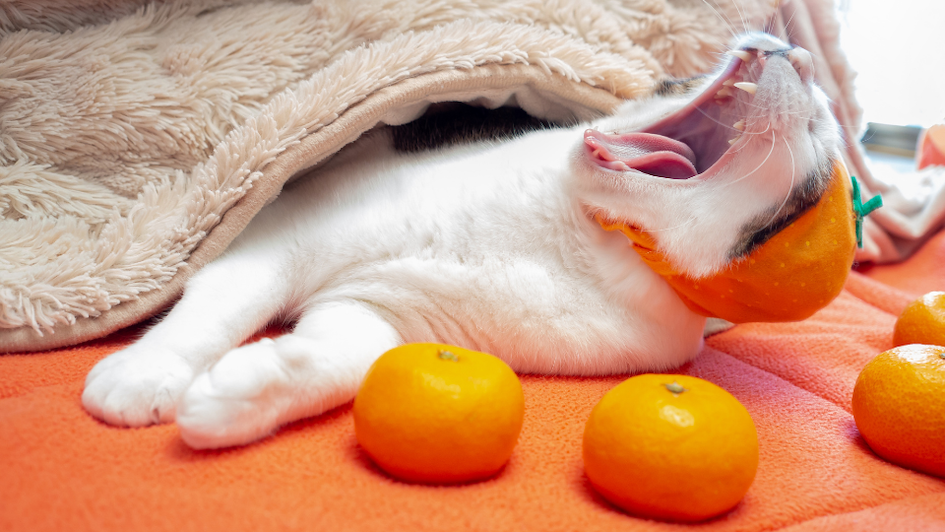
A Kotatsu table provides not only an energy-efficient way to keep yourself warm and cozy during the winter but also a place within your home where many special family memories will be created. It is also the celebration of a unique aspect of Japanese culture. With so many amazing benefits of using a kotatsu table, what are we waiting for? Now that you are practically a Kotatsu expert after reading this article, you are ready to go ahead and bring home your very own Kotatsu table!
Shop Kotatsu on ZenMarket